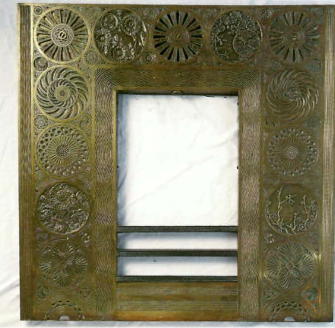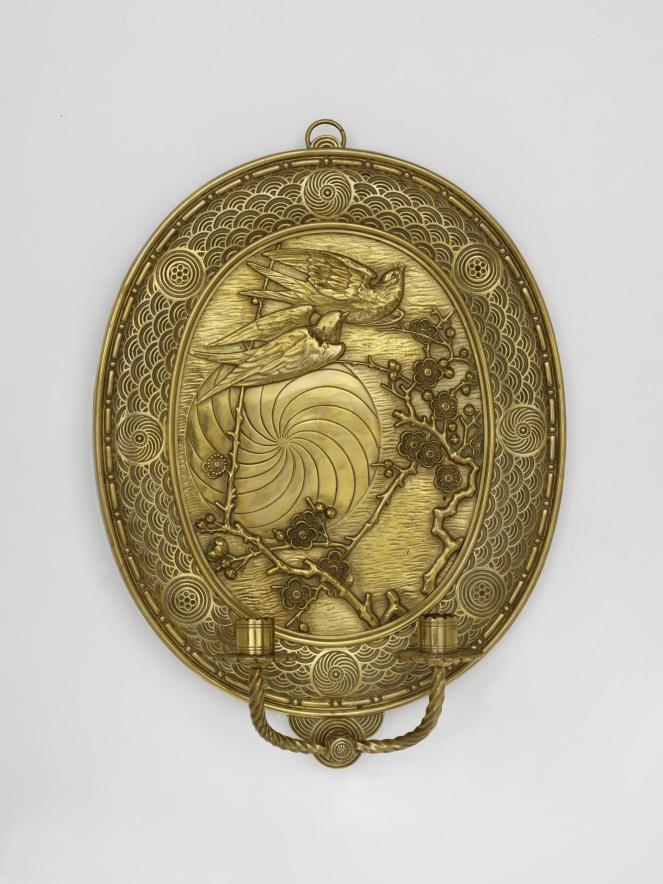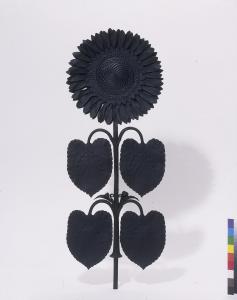I have to confess, I have never loved the 19th-century Arts and Crafts style.
Though, I admit, I do sometimes fall prey to being a bit fickle when it comes to interior design trends, and can occasionally be swayed by glossy home photo shoots in magazines and ‘before-and-after’ make-over programmes, this time, it’s just not happening.
Despite the Arts and Crafts ‘look’ being pushed by the latest interior and antiques-related programmes and magazines – or maybe it’s just coincidentally featuring in the ones I happen to watch/read – I remain unconvinced. Take the work of Archibald Knox, for example, I can see his pieces were modern for their time, have a quality of design and manufacture and yet, I can’t bring myself to like either the romanticised looking back to Celtic craftsmanship of Knox’s product designs or the clunky medieval style found in many pieces of Arts and Crafts furniture. The blurred multi-colour enamelling of Knox and the colours of the Ruskin pottery, to me, seem a bit hesitant, slightly wishy-washy.

Then, a couple of weeks ago, I saw a programme that showed an Arts and Crafts house and, amongst the handbeaten copper and trailing vine wallpaper, something caught my eye, a fireplace of all things. With straight lines, bold circles with Japanese-style motifs, it seemed as if there were elements of Edwardian simple design and bold exotic Art Deco design, slightly anachronistic if that were the case. It turned out that it was designed by Thomas Jeckyll, who I had never heard of before, and a quick internet search labelled him as an architect-designer of the Aesthetic Movement, a style I had heard of, but knew little about – cue two weeks of internet and library research…
Arts and Crafts or Aesthetic?
My first task was to try and pin down what the relationship was between the Aesthetic Movement and the Arts and Crafts Movement in Britain. Each website seemed to have a slightly different definition or varied on dates and people involved, so I turned quite quickly to the Tate Gallery and Victoria and Albert Museum for help and found opposing views even between these two titans of the art world.
The Tate Gallery places the Arts and Crafts movement as beginning with the “the founding of the design firm Morris and Co. in 1861 by William Morris“1 and the Aesthetic Movement as flourishing “in the 1870s and 1880s […] as part of the revolution in design initiated by William Morris, with the foundation of Morris & Co in 1862.” 2
The Victoria and Albert Museum (V&A) instead defines the Aesthetic Movement as part of a “Cult of Beauty“3 in the 1860s and places the Arts and Crafts Movement as a later development: “It began in Britain around 1880 and quickly spread across America and Europe before emerging finally as the Mingei (Folk Crafts) movement in Japan.
It was a movement born of ideals. It grew out of a concern for the effects of industrialisation: on design, on traditional skills and on the lives of ordinary people. In response, it established a new set of principles for living and working. […] The Movement took its name from the Arts and Crafts Exhibition Society, founded in 1887, but it encompassed a very wide range of like-minded societies, workshops and manufacturers.
In Britain the disastrous effects of industrial manufacture and unregulated trade had been recognised since about 1840, but it was not until the 1860s and 1870s that architects, designers and artists began to pioneer new approaches to design and the decorative arts. These, in turn, led to the foundation of the Arts and Crafts Movement.” 4
So, where the Tate states that the “The Arts and Crafts movement is often seen as the starting point for modern design approaches […] and was a key direct influence on the Aesthetic Movement and Art Nouveau” 5, the V&A has the Aesthetic Movement as forming the original founding artistic ideals that “sparked a revolution in the architecture and interior decoration of houses that led to a widespread recognition of the need for beauty in everyday life“6



The V&A definition rings more true for me, as, in the years the Tate places the flourishing of the Aesthetic Movement, Thomas Jeckyll, was already suffering the “debilitating [mental] breakdowns that required hospitalisation and ultimately lead to his death“7 in 1881. Christopher Dresser, too, showed many of his designs in the 1862 International Exhibition and in the same year wrote his book: The Art of Decorative Design 8 and both men’s product designs, to me seem more modern, enduring and revolutionary than that of many of the Arts and Crafts designs that I have seen.
Thomas Jeckyll 1827-1881
My knowledge of Thomas Jeckyll comes almost entirely from the book: “Thomas Jeckyll Architect and Designer, 1827-1881” by Susan Weber Soros and Catherine Arbuthnott and from the V&A online collections so, for the sake of this short article, I have used a summary from the V&A catalogue:

“Thomas Jeckyll (1827-81), architect and designer, was the son of a Norfolk Nonconformist minister, who ran a successful practice both in Norwich and in London. It was Jeckyll’s introduction to the so called Chelsea aesthetes, a group which included Rosetti, Whistler, Nesfield and Godwin which changed his artistic direction. It was, in part, their influence which encouraged Jeckyll to assimilate the vocabulary of East Asian design. Jeckyll’s success in achieving this was later acknowledged by the critic Gleeson White who described Jeckyll as “the first to design original work with Japanese principles assimilated – not imitated.”
Jeckyll’s major success with Barnards was his copious number of designs for the front panels of their revolutionary and hugely popular range of slow burning combustion fireplaces. Their main feature was a long and deep grate, narrowly proportioned to admit air through front bars rather than underneath, thus reducing the flow of air to the coal which burnt more slowly. The result was a more efficient and economical grate producing more heat with less coal. Jeckyll started to design the front panels for these fireplaces incorporating Japanese ornament in 1873 and for the rest of that decade, designed a considerable variety in the same manner in all sizes and shapes. They proved to be enormously popular both throughout Britain and abroad. The simplest versions in cast iron could cost as little as one pound; the most elaborate in cast brass upwards to £20. Architects as distinguished as Norman Shaw incorporated them into their buildings. Christopher Dresser specified them for his two architectural projects, Alangate in Halifax and Bushloes House in Leicester. Jeckyll in association with Barnards achieved what many notable 19th century design reformers could not. They produced a quality product that was accessible to a mass market.”9


I have been very dismissive of the Arts and Crafts style, not liking many of its products myself, however, having spent only a couple of weeks looking into this period more closely, I think I understand the Arts and Crafts Movement a bit better knowing where and how it originated. From the perspective of someone who didn’t have to live through the Industrial Revolution, I have always admired the craftsmanship in Victorian engineering, so perhaps that is why I am more drawn to Jeckyll’s designs of cast iron and bronze than to the designs by Morris that react against machinery and impose a moral duty on design. I have also treated the two styles as entirely separate which, of course, they weren’t, each one borrowed influences from the other and, while the quote below is from the V&A’s Arts and Crafts pages, elements of it hold true for both design movements:
“This was a movement unlike any that had gone before. Its pioneering spirit of reform, and the value it placed on the quality of materials and design, as well as life, shaped the world we live in today.”(5)
Footnotes
1. The Tate Gallery Glossary: Arts and Crafts definition
2. The Tate Gallery Glossary: The Aesthetic Movement
3. The Victoria and Albert Museum: Article on Aestheticism
4. The Victoria and Albert Museum: article on the Arts and Crafts Movement
5.The Tate Gallery Glossary: Arts and Crafts definition
6.The Victoria and Albert Museum: Article on Aestheticism
7 Susan Weber Soros, Catherine Arbuthnott: “Thomas Jeckyll: Architect and Designer, 1827-1881″ published for Bard Graduate Center for Studies in the Decorative Arts, Design & Culture, New York by Yale University Press: 2003.
8 http://www.christopherdresser.co.uk/
9. The Victoria and Albert Museum: catalogue details for Thomas Jeckyll Wall Sconce
Useful Links:
Victoria and Albert Museum: ‘The Cult of Beauty’ and the style guides for Aestheticism and Arts and Crafts.
Tate Gallery: Glossary pages for Arts and Crafts and Aesthetic Movement.
Virginia Commonwealth University – These and Dissertations for Theses on Jeckyll and Whistler’s Peacock Room by Cynthia Fischer 2013
